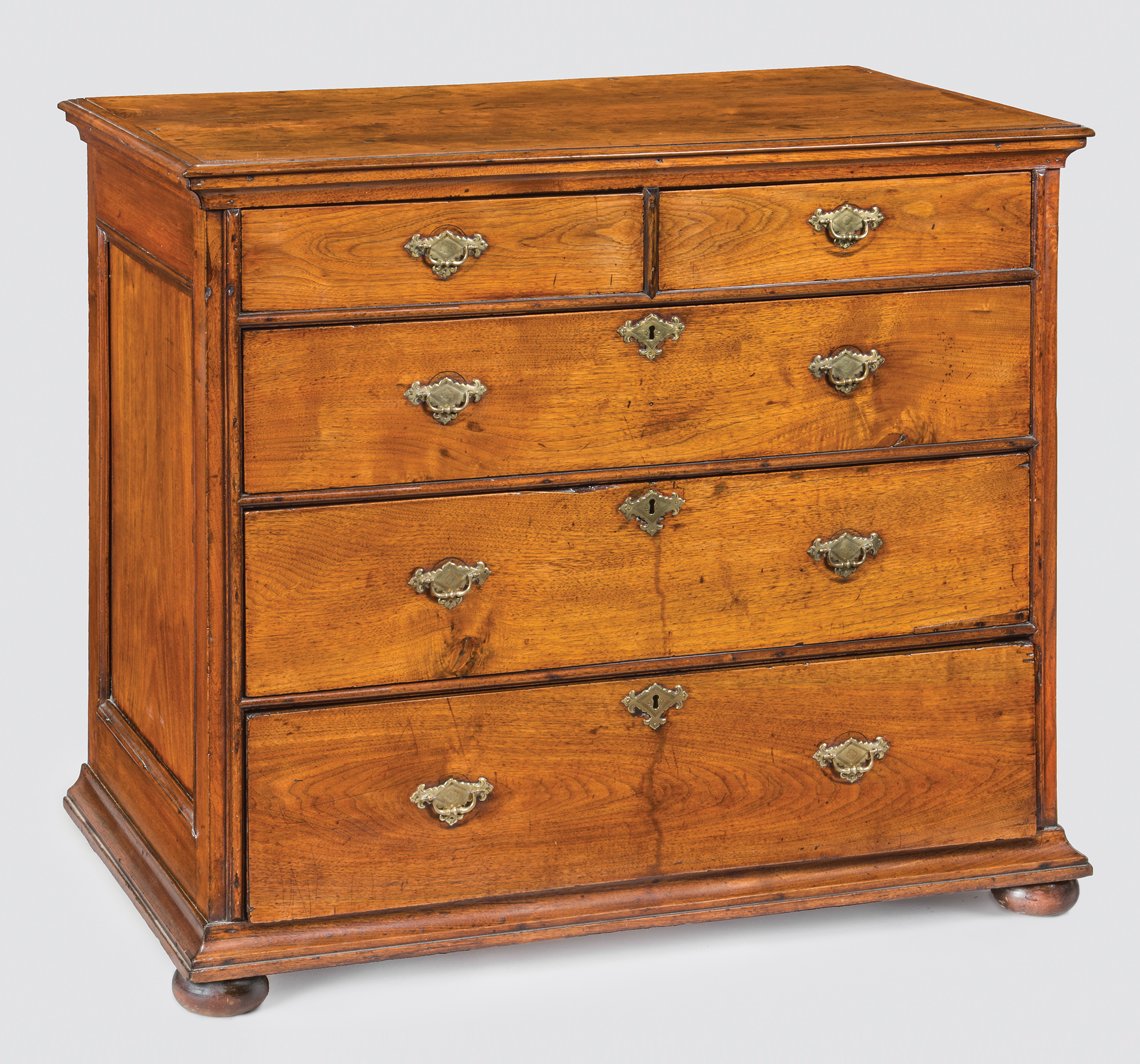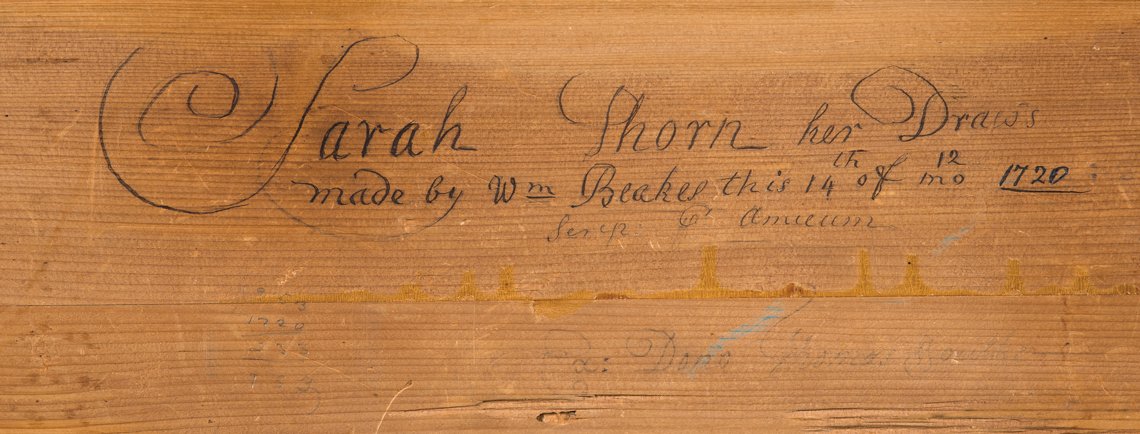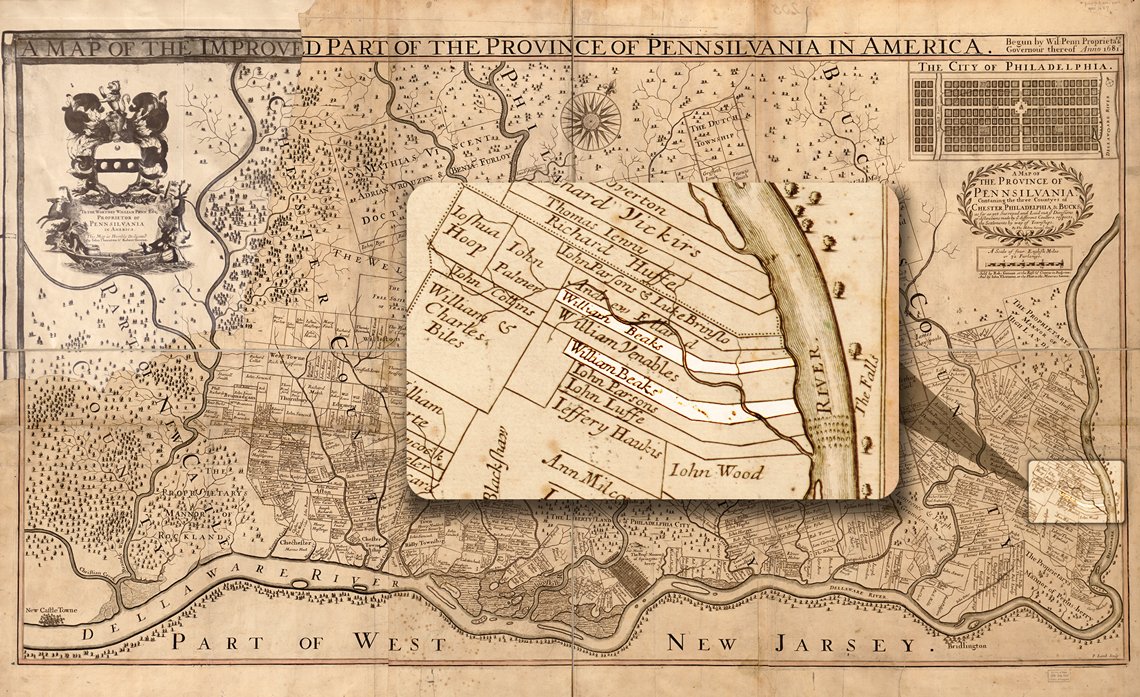Dietrich American Foundation: William Beakes, Joiner
 |
William Beakes (1691–1761) was one of the very few joiners working in the Delaware River Valley in the first decades of the eighteenth century who signed the furniture he made. William Macpherson Hornor Jr. included him in his “astonishing roll of nearly one hundred” woodworkers and other individuals working in allied trades in Philadelphia before 1722. Beakes’ inclusion was based on documents that cited him as a joiner, though no objects by the craftsman had been identified at that time. By the 1970s, Cathryn J. McElroy had found “only three pieces (of furniture) bearing inscriptions” made in Philadelphia before 1732: “two chests of drawers signed by William Beake[s] and the desk bearing the stamp of Edward Evans.” Subsequently, the furniture historian Benno Forman described the white chalk inscription on the interior of the proper left side panel of the signed chest McElroy illustrated as “William Beake[s] 171_.” Forman continued, “the sole biographical reference to William Beakes is that he witnessed the will of joiner William Till in 1711.”
Previous furniture historians were unable to unearth details of William Beakes in part because they presumed him to be a Philadelphia artisan. But he may not have worked as a journeyman or operated his own shop in Philadelphia for long, if at all. The recent survey of a third chest of drawers signed by Beakes in the collection of the Dietrich American Collection has contributed to our knowledge of William Beakes’ life and work, the movement of joiners within the Delaware River Valley, and the intricate network of Quaker families and artisans throughout the region during the early decades of the eighteenth century.
 |
Fig. 1: Chest of drawers by William Beakes (1691–1761). Delaware River Valley, probably Burlington County, New Jersey, 1720 or 1721. Black walnut, hard pine, Atlantic white cedar, brass hardware, iron locks. H. 36½, W. 40¼, D. 23 in. The Dietrich American Foundation. The front turned feet and the rear stile feet have been reduced in height. The chest originally had single-drop drawer pulls. Photo by Gavin Ashworth. |
 |
Fig. 2: Bottom of the proper right upper drawer with an inscription in graphite partially strengthened in ink: Sarah Thorn her Draws/made by Wm Beakes this 14 of 12 mo 1720/Ex: Dono (by gift) Thomas Foulkes. Beakes employed a digit to indicate the month, 12. If Beakes was using the Julian calendar (Old Style) rather than the Gregorian calendar (New Style), he completed the chest in February 1721. Photo by Gavin Ashworth. |
Both McElroy and Forman were unaware of the existence of a third chest of drawers signed by Beakes that was purchased in 1965 by H. Richard Dietrich Jr. (1938–2007) (Fig. 1). Written in graphite on the bottom of the upper proper right drawer is the inscription “Sarah Thorn her Draws/made by Wm Beakes this 14 of 12 mo 1720” over “Ex: Dono Thomas Foulkes” (Fig. 2). This inscription identifies the maker of the chest as William Beakes, who it was made for, Sarah Foulke Thorn (1702–before 1774), and her father, Thomas Foulkes (1665–1739), who presented it to her. As historian Ned Cooke observed, the real value to Dietrich of this rather plain chest with some condition issues, was its documentation. “An inscription identifying the original owner and maker is extremely rare in the first two generations of Pennsylvania’s history.”
Three successive generations of William Beakes’ in America contributed to the difficulty in determining when and where William Beakes worked. William Beakes I (d. 1687), the grandfather of the joiner, was one of William Penn’s first purchasers in Pennsylvania. Beakes I and his family, including William Beakes II (1663–1711), arrived in Pennsylvania in 1682. Their two lots in Falls Township, Bucks County, are long, narrow rectangles ending at the Delaware River (Fig. 3). In 1690 William Beakes II married Elizabeth Worrilaw (1671–1705) of Chester, Pennsylvania. The future joiner, William Beakes III, was born the following year.
 |
Fig. 3: Thomas Holme (1724–1795), A Map of The Province of Pennsilvania in America, Containing the three Countyes of Chester, Philadelphia, & Bucks. Thomas Holme, London, 1705. Library of Congress Geography and Map Division Washington, D.C. 55½ x 80 inches. The two lots of William Beakes I are highlighted in the detail overlay. |
The 1710 will of Susanna Brightwen Warrilaw (1640–1710), the second wife of Thomas Warrilaw (1626–1709), father of Elizabeth Warrilaw Beakes and grandfather of William Beakes III, documents Beakes III as a joiner and an apprentice to the English-immigrant William Till (1676–1711). After first specifying payments to her nephew and niece, both living in Devon, England, she gives “unto William Beaks Jun. who is now an apprentice with William Till of Philadelphia aforesaid joyner the sum of five Pounds money.” In 1703 Till married Ann Warden in Philadelphia and would have been in position to take on an apprentice. William Beakes III likely began his apprenticeship with Till in 1705 at the time his father remarried and moved from Pennsylvania to Burlington County, New Jersey. Thomas Warrilaw and William Till, an exact contemporary of Warrilaw’s children, both immigrated from Staffordshire, England. A family connection may have precipitated Beakes III’s apprenticeship with Till. Thomas Warrilaw with his second wife Susanna had recently moved to Philadelphia from Chester. Their move would have eased the young Beakes III’s transition to his new life in the city.
 | |
 | |
Fig. 4: Sarah’s descendants continued to inscribe their names and dates on the bottoms of both small drawers in the top tier of the chest. A) Isaac Thorn (1759–1837) or his son, Isaac Thorne Jr. (1786–1844), signed a drawer in 1826. Another Thorn family member signed the chest in the summer of 1869. B) In 1953, an owner of the chest did a math problem on the bottom of a drawer and determined the chest was 233 years old. |
Till died in 1711 as William Beakes III was nearing the end of his apprenticeship. His grandfather and step-grandmother were also recently deceased. Did Beakes III choose to stay and continue to work in Philadelphia or relocate and practice his craft elsewhere? The inscription on the drawer of the Foundation’s chest led our investigation away from Philadelphia across the river to New Jersey.
Thomas Foulkes immigrated from Derbyshire, England, to Crosswicks, a village in Chesterfield Township, Burlington County, New Jersey, sometime before his marriage there in 1688 to Elizabeth Curtis. Sarah Foulkes (1702–1774) was the couples sixth child. Beakes III may have been working in or near Crosswicks when he made the chest for Sarah prior to her marriage to Joseph Thorn (1700–1775). In 1730, Beakes observed the wedding of one of his half-siblings at Chesterfield Meeting in New Jersey. By 1748 he had moved permanently to Upper Freehold, Monmouth County, New Jersey, when he was listed as a freeholder in the colony. In his 1761 will, Beakes III identified himself as a “Joyner being in health of body & of sound & perfect mind & memory” though he died later that same year. In the inventory of his estate, a “pare of Chestardraws, Joyners tools & other things” in the large front chamber were valued at 23 pounds 19 shillings. He may still have been working part-time as a joiner, but the great amount of farming equipment, livestock, and stored grain included in the inventory indicate that he was also a yeoman, working a modest plantation.
Trained in Philadelphia, William Beakes III followed family members to New Jersey shortly after his apprenticeship ended. The precise reason for Beakes III’s move remains unknown. It is doubtless though, that family, social, and religious ties contributed to his desire to relocate and ultimately to his success as a joiner and later, as a yeoman. Beakes III’s furniture fulfills the Quaker esthetic, “Of the best sort, but plain,” but their plainness belies the value of the information they can provide us.
This article is the third in a series featuring the Dietrich American Foundation’s collection, with an eye toward presenting the collection’s strength in furniture. We are delighted to present these articles as a type of crowd sourcing exercise, where responses and information shared by readers can inform the research. New information gleaned will be provided over the course of the series. As is always the Foundation’s mission, we are excited to share findings and stories about people, places, and history that are revealed through our research. Contact information is in the author bio below. For information about the Dietrich American Foundation, visit dietrichamericanfoundation.org.
1. William Macpherson Hornor Jr., Blue Book of Philadelphia Furniture (Philadelphia, 1935), 2. The surname Beakes has been variously spelled historically; William Beakes III signed his furniture and his will “Beakes.”
2. Cathryn J McElroy, “Furniture in Philadelphia: The First Fifty Years,” Ian Quimby, ed., Winterthur Portfolio 13, American Furniture and Its Makers, 1680–1758 (1979): 61. One of the two chests inscribed by Beakes is illustrated on page 73. The unpublished chest is in a private collection.
3. Benno M. Forman, “The Chest of Drawers in America, 1635–1730: The Origins of the Joined Chest of Drawers,” Winterthur Portfolio 20, no. 1 (Spring 1985): 28–29, fig. 26. The last digit of the date, as well as the last two letters of Beakes’ name, are obscured by a drawer runner in the chest Forman examined.
4. Edward S. Cooke, Jr., “Furniture,” H. Richard Dietrich III, Deborah M. Rebuck, ed., In Pursuit of History, A Lifetime of Collecting Colonial American Art and Artifacts, Philadelphia Museum of Art, 2019, pp. 114-115, cat. 2.7. The existence of the Foundation’s chest and its inscription was first made public at the 2014 Sewell C. Biggs Winterthur Furniture Forum, Philadelphia Furniture: New Inquiries and Insights, during Storb’s talk, “Making it in Philadelphia: John Head and the Joyners’ Craft.” The inscription uses the Julian calendar. The “14th of 12 mo” 1720 is equivalent to February 14, 1721 in the Gregorian calendar.
5. William Beakes I was one of the founders of the first Quaker meeting in Pennsylvania in 1682.
6. Philadelphia County, Philadelphia Wills, 1689–1819, digital database. As was tradition with only two William Beakes living at the time, William III used the suffix Jr. Warrilow is an alternate surname spelling used by some members of the family. Philadelphia Monthly Meeting, Minutes, 1682–1714. This is most likely the document that allowed Hornor to identify Beakes as a joiner.
7. Till’s will and estate inventory survive. His “Working Tools of all sorts and stuff unwrought” were valued at 30 pounds. His wood inventory included pine, walnut, mahogany, red cedar, cherry tree, and pear tree boards, mahogany, and oak scantling, and bolts of cedar. “Locks, Drops, Scuttgeons, coffin handles, hinges, & etc,” valued at 20 pounds were, in the garret of his house. William Beakes III was a witness to the will. Philadelphia Wills, 1711-216-A.
8. In 1723 at Chesterfield Monthly Meeting, Joseph Thorn and Sarah Foulkes declared their intent to marry. The discrepancy of the inscription being dated before Sarah’s marriage, though she is addressed by her husband’s family name, is the subject of ongoing research into William Beakes III’s life and work. There was a strong connection between the Chesterfield and Falls Meetings. Relationships between the Beakes, Foulkes, and Thorn families likely developed in the late seventeenth century.
10. I am grateful to Jackie Killian for sharing references to these events and for her spirit of collaboration during her research on Stacy Beakes (1706– ca. 1745), a prominent cabinetmaker in Trenton, New Jersey, and William Beakes III’s half sibling. See Jackie Killian, Craft and Commerce in the Early Delaware River Valley, Delaware Antique Show Catalogue, 2014, and United by Water: Cabinetmaking Traditions in the Delaware River Valley, 1670–1740, M.A. thesis, Winterthur Program in American Material Culture, Lois F. McNeil Fellow, University of Delaware, 2014.
11. New Jersey State Archives, will no.: 2581-2588M.
Christopher Storb is a furniture conservator, woodworking historian, and wood artist. Please send comments and related research to cstorb@gmail.com, or call 610.212.5528.
This article was originally published in the 21st Anniversary/Spring 2021 issue of Antiques & Fine Art magazine, a fully digitized version of which is available at www.afamag.com. AFA is affiliated with Incollect.com.
 |



























